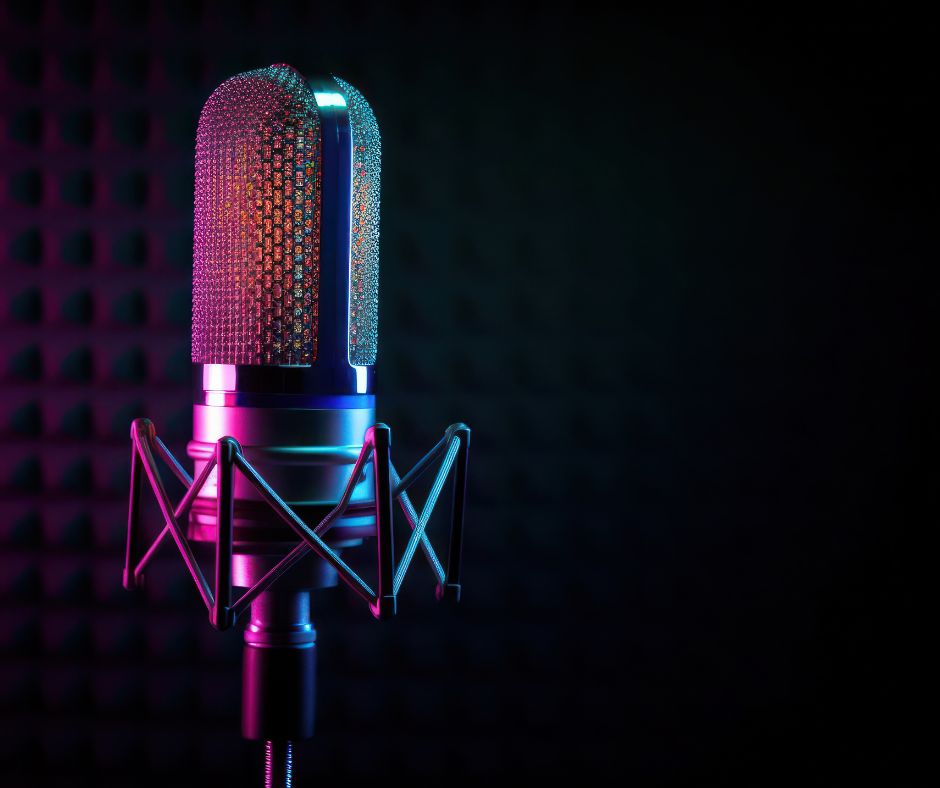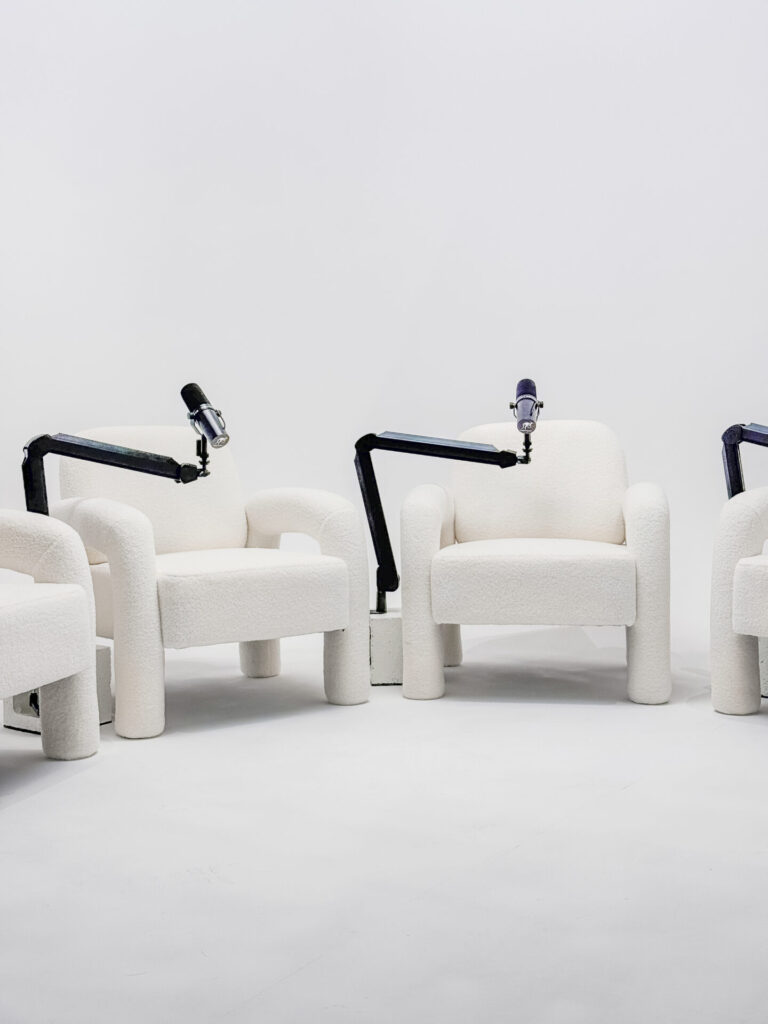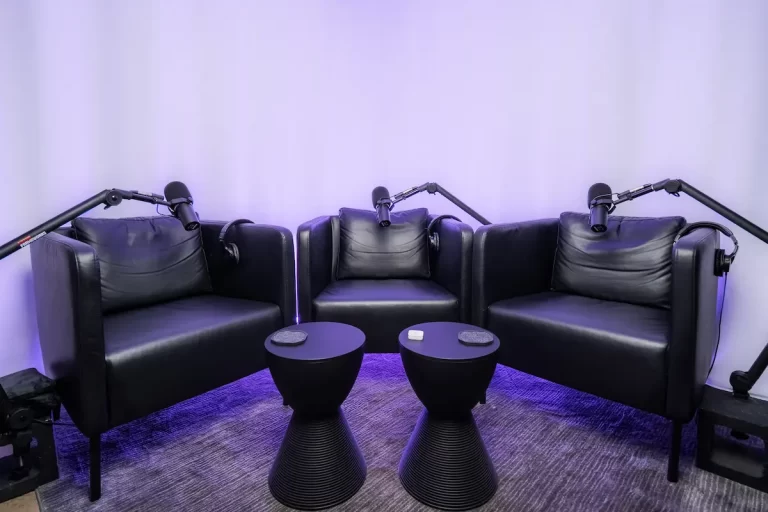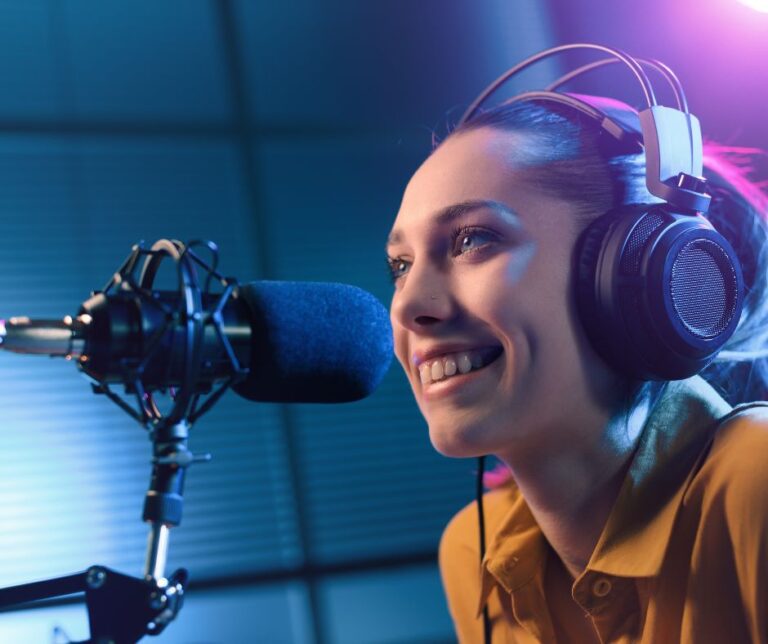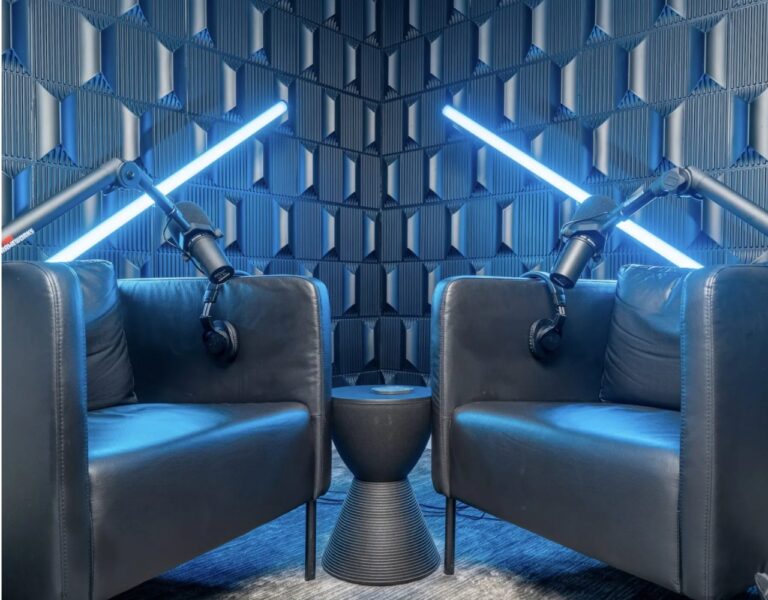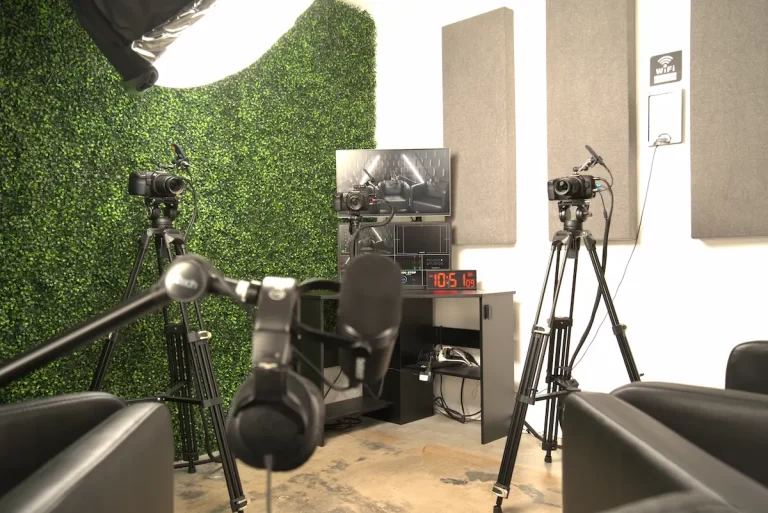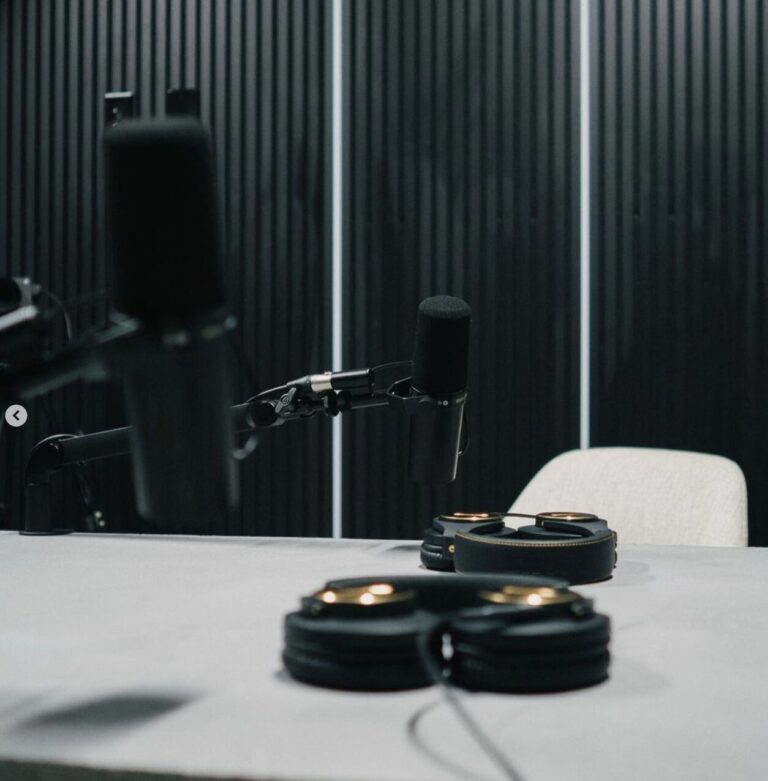Essential Equipment for Setting Up a Professional Podcast Studio
Podcasting has become an increasingly popular medium for content delivery, and having a professional studio is becoming more important than ever. A podcast studio is a space designed for recording audio and video content. It typically consists of the necessary podcast equipment, such as microphones, headphones, and computers. To ensure your podcast is of the highest quality possible, it’s important to choose the right equipment and set up your podcast studio properly.
In this post, we’ll discuss how to set up a professional podcast studio and the essential podcast equipment you need for it.
Book Your Next Project With Us
Boost your creative process at Media Pouch Studios – your all-in-one hub for creation and growth
Room Acoustics
Importance of Room Acoustics
Good acoustics in a recording space is one of the most important essential podcast equipment for achieving quality recordings. Poor acoustics can lead to unwanted reverberation, echo, and other detrimental effects on the sound of your podcast. Room acoustics mainly depend on the size, shape, and material of a room.
Treating Room Acoustics
To achieve optimal studio acoustics for recording podcasts, you’ll need to treat the room. This involves using acoustic foam, sound-absorbing blankets, and other materials to help reduce reverberation and echoes in a space.
Types of Room Treatments
The type of treatment you choose depends on your budget and needs. Common treatments are absorptive materials such as acoustic foam, diffusive panels, bass traps, and sound-dampening curtains.
Microphones

The Significance of Microphones in Podcasting
Choosing the right microphone is essential for producing quality recordings. Different types of microphones offer different features and benefits that can affect the sound quality of your podcast.
Types of Microphones
When selecting a microphone for podcasting, there are three main categories to consider: dynamic (such as the Shure SM7B), condenser (such as the Neumann TLM 102), and USB microphone (such as the Blue Yeti). Each microphone type has its benefits and drawbacks, so it’s important to do your research before making a purchase.
Advantages and Disadvantages of Different Types of Microphones
Dynamic microphones are generally more durable than other types and have better sound isolation, but they tend to be more expensive. Condenser microphones offer high-quality audio recordings but require an external power source. A USB microphone is usually less expensive than other types and don’t need additional hardware for setup, but their sound quality is not always as good
Headphones
The Role of Headphones in Podcasting
Headphones are a crucial part of a modern podcast studio setup. They allow you to hear the audio as it’s being recorded, offering real-time feedback on sound levels and EQ settings. Additionally, headphones help in monitoring the mix of multiple audio sources simultaneously.
Types of Headphones
When selecting headphones for your podcasting setup, there are two main types to choose from: over-ear and in-ear monitors. Over-ear models tend to be more comfortable but can block some outside noise. In-ear monitors provide better isolation and are often less bulky than over-ears.
Benefits of Using Headphones in Podcasting
Using headphones while recording podcasts allows you to hear any subtle nuances or errors that may not be audible through speakers. Additionally, headphones provide a more accurate representation of the sound levels and EQ settings while recording, helping you to achieve the best possible recordings.
Audio Interface
What Is an Audio Interface?
An audio interface is a device that connects your microphone and other input sources to your computer. It’s essentially a bridge between analog and digital signals, allowing you to record high-quality audio directly into your computer or other digital devices.
The Importance of an Audio Interface
An audio interface is essential for creating professional-sounding podcasts. It provides an optimal signal path for audio sources such as microphones and instruments, improving overall sound quality by reducing noise and interference in recordings.
Different Types of Audio Interfaces
When selecting an audio interface, there are two main types to choose from: USB and Firewire. Each type has its benefits and drawbacks, so it’s important to do your research before making a purchase.
For example, USB audio interfaces are generally more affordable and easier to use, but they can be limited in terms of input and output options. Firewire models offer more flexibility but tend to be more expensive.
Features To Consider When Selecting an Audio Interface
When selecting an audio interface for podcasting, it’s important to consider the number of inputs and outputs you need, as well as the type of connections you require (USB or Firewire). Additionally, look for features such as preamps and EQ controls to help shape your sound.
Mixer
What Is a Mixer?
A mixer is a device used to combine multiple audio sources into one signal. It allows you to adjust levels, add effects, and blend different sounds.
Why a Mixer Is Essential in Podcasting
Mixers are essential in podcast production, as they give you the ability to control and edit your audio sources with precision. A mixer allows you to adjust levels, add effects, and blend different sounds, resulting in a polished recorded podcast.
Types of Mixers
When selecting a mixer for your podcast setup, there are two main types to choose from: analog and digital mixers. Analog models provide more flexibility but require more manual adjustment, while digital mixers offer automated controls and easier setup.
Features To Consider When Selecting a Mixer
When selecting a mixer for podcasting, it’s important to consider the number of inputs and outputs you need as well as the type of connections you require (analog or digital). Additionally, look for features such as EQ controls and preamps to help shape your sound.
Preamp
What Is a Preamp?
A preamp is an electronic device that amplifies a signal from a microphone or other input source before it’s sent to an audio interface or mixer. It helps to increase the gain and improve the overall sound quality of recordings.
The Importance of a Preamp in Podcasting
Having a preamp in your podcast setup is essential for getting high-quality recordings. A preamp allows you to boost weak signals while reducing noise and interference, resulting in clear, professional-sounding podcasts.
Types of Preamps
When selecting a preamp, there are two main types to choose from tube and solid-state. Tube preamps offer warmer tones and more natural sound, while solid-state models provide a more accurate representation of the source signal.
Features To Consider When Selecting a Preamp
When selecting a preamp for podcasting, it’s important to consider the number of inputs and outputs you need as well as the type of connections you require (tube or solid-state). Additionally, look for features such as gain controls and EQ settings to help shape your sound.
Pop Filter
What Is a Pop Filter?
A pop filter is an acoustic device used to reduce sudden bursts of air that occur during speech and singing. It helps to improve the clarity of recordings by reducing plosives (p-pops) and other unwanted sounds.
The Significance of a Pop Filter in Podcasting
Having a pop filter in your podcast setup is essential for getting clean, professional-sounding recordings. A pop filter helps to reduce plosive sounds, resulting in clear and precise vocals that don’t distract from the content of the podcast.
Types of Pop Filters
When selecting a pop filter for your podcast setup, there are two main types to choose from: foam and metal mesh filters. Foam filters are more affordable but less durable, while metal mesh models offer greater protection against plosives but tend to be more expensive.
Benefits of Using a Pop Filter
Using a pop filter in your podcast setup offers numerous benefits. It helps to reduce plosive sounds, resulting in clear and precise recordings. Additionally, it helps protect your microphone from potential damage due to fluctuating air pressure.
Shock Mount
What Is a Shock Mount?
A shock mount is an acoustic device used to isolate the microphone from outside vibrations. It helps to reduce unwanted noise and interference that can occur during recording sessions, resulting in improved audio quality.
The Importance of a Shock Mount in Podcasting
Having a shock mount in your podcast setup is essential for getting high-quality recordings. A shock mount helps to isolate the microphone from external vibrations, resulting in clean and consistent sound.
Types of Shock Mounts
When selecting a shock mount for your podcast setup, there are two main types to choose from: suspension and elastic mounts. Suspension mounts are more durable but tend to be bulkier, while elastic mounts offer greater protection against external vibrations but may not be as sturdy. A benefit of renting a podcast studio is that you will have all necessary podcast equipment to help you achieve your podcast goals.
Benefits of Using a Shock Mount
Using a shock mount in your podcast setup offers several benefits. It helps to reduce unwanted noise and interference, resulting in improved audio quality. Additionally, it helps protect the microphone from potential damage due to fluctuating air pressure or other sources of vibration.
Mic Stand
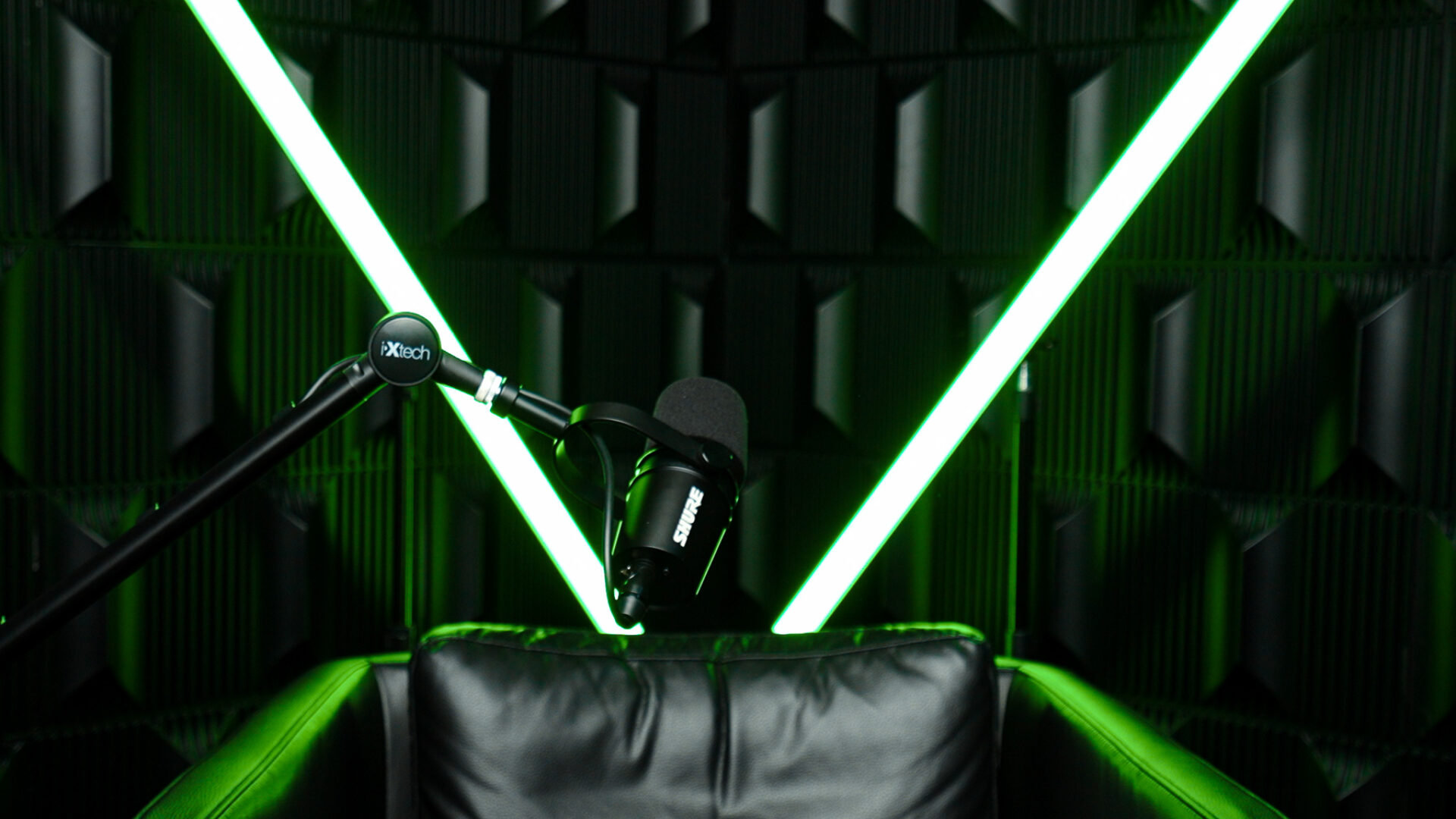
The Importance of a Mic Stand
Having a mic stand in your podcast setup is a must for getting high-quality recordings. A mic stand helps to hold the microphone in place, keeping it steady and secure during recording sessions.
Different Types of Mic Stands
When selecting a mic stand for podcasting, there are two main types to choose from: straight and boom arms. Straight stands offer more stability but take up more room, while boom arms provide greater flexibility but may be less sturdy.
Features To Consider When Selecting a Mic Stand
When selecting a mic stand for podcasting, it’s important to consider the weight of your microphone as well as any accessories you may require (such as shock mounts or pop filters). Additionally, look for features such as adjustable height so that you can easily adjust the position of the microphone depending on the situation.
Boom Arm
What Is a Boom Arm?
A boom arm is an acoustic device used to extend and position the microphone in recording sessions. It helps to provide greater flexibility and maneuverability when positioning the microphone, resulting in improved audio quality.
The Importance of a Boom Arm in Podcasting
Having a boom arm in your podcast setup is essential for getting high-quality recordings. A boom arm helps to extend and position the microphone, allowing you to easily adjust its placement during recording sessions.
Types of Boom Arms
When choosing a boom arm for your podcast setup, there are two main types to choose from: mechanical and electrical arms. Mechanical arms offer more stability but tend to be bulkier, while electrical arms provide greater flexibility but may not be as sturdy.
Benefits of Using a Boom Arm
Using a boom arm in your podcast setup offers numerous benefits. It helps to extend and position the microphone, resulting in clear and precise recordings. Additionally, it helps protect the microphone from potential damage due to fluctuating air pressure or other sources of vibration.
Recording Software
The Significance of Recording Software in Podcasting
Having recording software in your podcast setup is essential for getting high-quality recordings. Recording software allows you to easily record and edit audio, giving you complete control over your podcast sound.
Different Types of Recording Software
When selecting recording software for podcasting, there are various programs available on the market today. Some of the most popular ones include Audacity, Reaper and Logic Pro X.
Features To Consider When Selecting Recording Software
When selecting recording software for podcasting, it’s important to consider features such as ease of use, compatibility with different operating systems and audio formats, and built-in effects or editing tools. Additionally, look for features such as support for multiple audio inputs and outputs.
Computer
What Is the Importance of a Computer in Podcasting?
A computer allows for recording, editing and publishing podcasts. A computer allows you to easily manage all aspects of podcast production, giving you full control over the sound and quality of your recordings.
Minimum Computer Requirements for Podcasting
When selecting a computer for podcasting, certain minimum requirements need to be met. These include at least 4GB of RAM, an Intel Core i5 or AMD Ryzen 5 processor, and 128GB of storage space. Additionally, look for features such as USB 3.0 ports and a dedicated graphics card (if possible).
Features To Consider When Selecting a Computer
You must also consider features such as portability, processing speed and memory. Additionally, look for features such as battery life and expandable storage space.
Soundproofing
What Is Soundproofing?
Soundproofing is the process of insulating a room from outside noise. It helps to reduce the amount of ambient noise in a recording environment, resulting in higher-quality recordings.
The Importance of Soundproofing in Podcasting
Having soundproofed walls and ceilings in your podcast setup is essential for getting high-quality recordings. Soundproofing helps to reduce the amount of ambient noise in the recording environment, allowing you to capture clear and precise audio.
Types of Soundproofing
When soundproofing your podcast studio, there are a variety of products available on the market today. These include acoustic foam panels, sound-dampening curtains and bass traps. Additionally, consider using rugs and carpets to help absorb excess reverberation in the space.
Benefits of Soundproofing
Using soundproofing in your podcast setup offers numerous benefits. It helps to reduce ambient noise and eliminate echoes and reverberations, resulting in higher-quality recordings. Additionally, it helps protect microphones from potential damage due to fluctuating air pressure or other sources of vibration.
Internet Connection
Why an Internet Connection Is Necessary for Podcasting?
Having an internet connection in your podcast setup is essential for streaming and publishing podcasts. An internet connection allows you to easily connect with listeners, allowing them to access and listen to your podcast on various devices.
Minimum Internet Requirements for Podcasting
When selecting an internet service provider (ISP) for podcasting, certain minimum requirements need to be met. These include a download speed of at least 3 Mbps and an upload speed of 1 Mbps. Additionally, look for features such as unlimited data usage and customer service availability.
Features To Consider When Selecting an Internet Service Provider
When selecting an ISP for podcasting, it’s important to consider features such as the cost of service, customer service availability and data usage limits. Additionally, look for features such as download and upload speeds, reliability and security measures.
Lighting
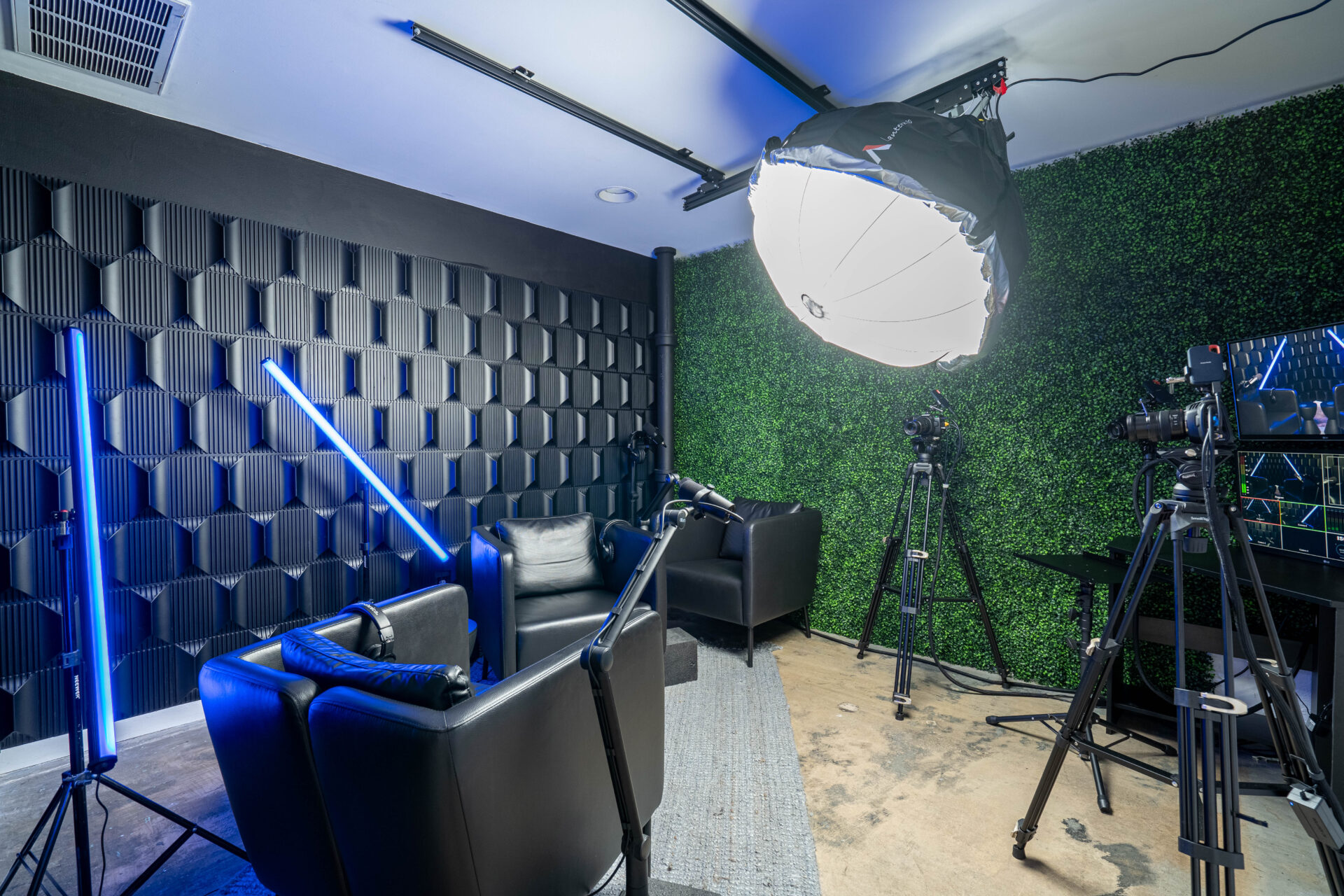
The Importance of Lighting in Podcasting
Proper lighting in your podcast setup helps with creating an inviting atmosphere that viewers can relate to. Proper lighting helps to create a consistent look and feel for each episode and allows your viewers to better connect with you and your content.
Types of Lighting
When selecting lighting for podcasting, there are a variety of products available on the market today. These include LED lights, fluorescent lights and natural light sources (such as windows). Additionally, consider using colored gels or filters to help create different lighting effects.
Benefits of Using Proper Lighting
Using proper lighting in your podcast setup offers numerous benefits. It helps to create an inviting atmosphere that viewers can relate to, resulting in a better connection between you and your audience. Additionally, it helps you to capture higher-quality footage and create visually stunning visuals for each episode.
Power Conditioner
What Is a Power Conditioner?
A power conditioner is an electronic device that helps protect audio equipment from fluctuations in electricity or other sources of interference. It also helps eliminate noise from the power line, resulting in clearer sound recordings and improved performance of your audio equipment.
The Importance of a Power Conditioner in Podcasting
Having a power conditioner in your podcast setup is critical for ensuring that your audio equipment operates at its peak performance. It helps to protect audio equipment from voltage spikes and other sources of interference, resulting in higher-quality recordings and improved sound clarity.
Types of Power Conditioners
When selecting a power conditioner for podcasting, there are a variety of products available on the market today. These include surge protectors, line filters, uninterruptible power supplies (UPS) and AC line conditioners. Additionally, consider features such as total output wattage capacity, noise reduction capabilities and overload protection.
Benefits of Using a Power Conditioner
Using a power conditioner in your podcast setup offers numerous benefits. It helps to reduce noise levels and improve sound clarity, resulting in higher-quality recordings. Additionally, it helps to protect your audio equipment from voltage spikes and other sources of interference.
Cables
The Importance of Cables in Podcasting
Having quality cables in your podcast setup is essential for ensuring the best possible sound quality. Cables help to transfer audio signals from one piece of equipment to another, resulting in clearer sound and improved performance of your audio equipment.
Types of Cables
When selecting cables for podcasting, there are a variety of products available on the market today. These include balanced cables, unbalanced cables and microphone cables. Additionally, consider features such as cable length and signal strength when selecting the best type of cable for your needs.
Features To Consider When Selecting Cables
When selecting cables for podcasting, it’s important to take into account features such as cable build quality, signal strength and length of the cable. Additionally, consider factors such as cost and ease of installation.
Book Your Next Project With Us
Boost your creative process at Media Pouch Studios – your all-in-one hub for creation and growth
Storage
The Significance of Storage in Podcasting
Having adequate storage space in your podcast setup is essential for storing audio files, video clips and other digital assets used in creating each episode. Without sufficient storage space, managing large amounts of data can become challenging and time-consuming. A podcast rental space will tackle this issue for you to make sure you have adequate storage for your digital files.
Types of Storage
When selecting storage for podcasting, there are a variety of products available on the market today. These include external hard drives, solid-state drives (SSD) and cloud storage solutions. Additionally, consider features such as storage capacity and transfer speeds when selecting the best type of storage for your needs.
Features To Consider When Selecting Storage
When selecting storage for podcasting, it’s important to take into account features such as data security, compatibility with other devices and cost. Additionally, consider factors such as backup options and transfer speeds.
Conclusion
Creating a professional podcast studio requires investing in quality equipment that is tailored to your specific needs. From microphones and power conditioners to lighting filters and cables, it’s important to ensure that you have the right equipment for producing high-quality audio. Additionally, having adequate storage space is essential for managing large amounts of data used in creating each episode.
Save yourself time and money bypodcast studio in Texas. At our podcast studio, we provide a professional setting equipped with all of the highest-quality podcast studio equipment you need to create a top-notch podcast.

